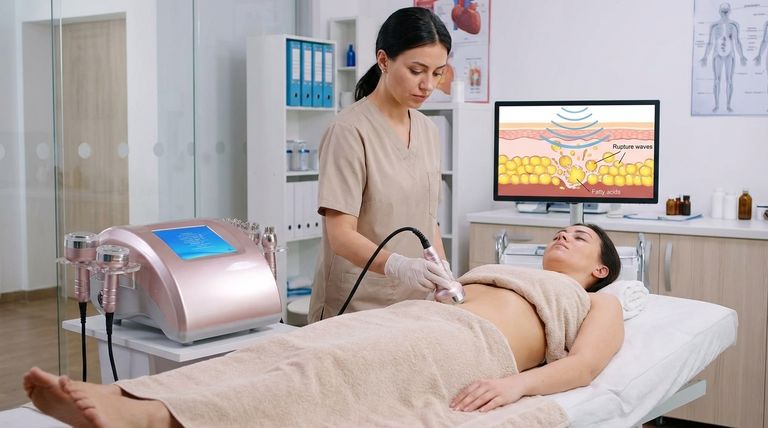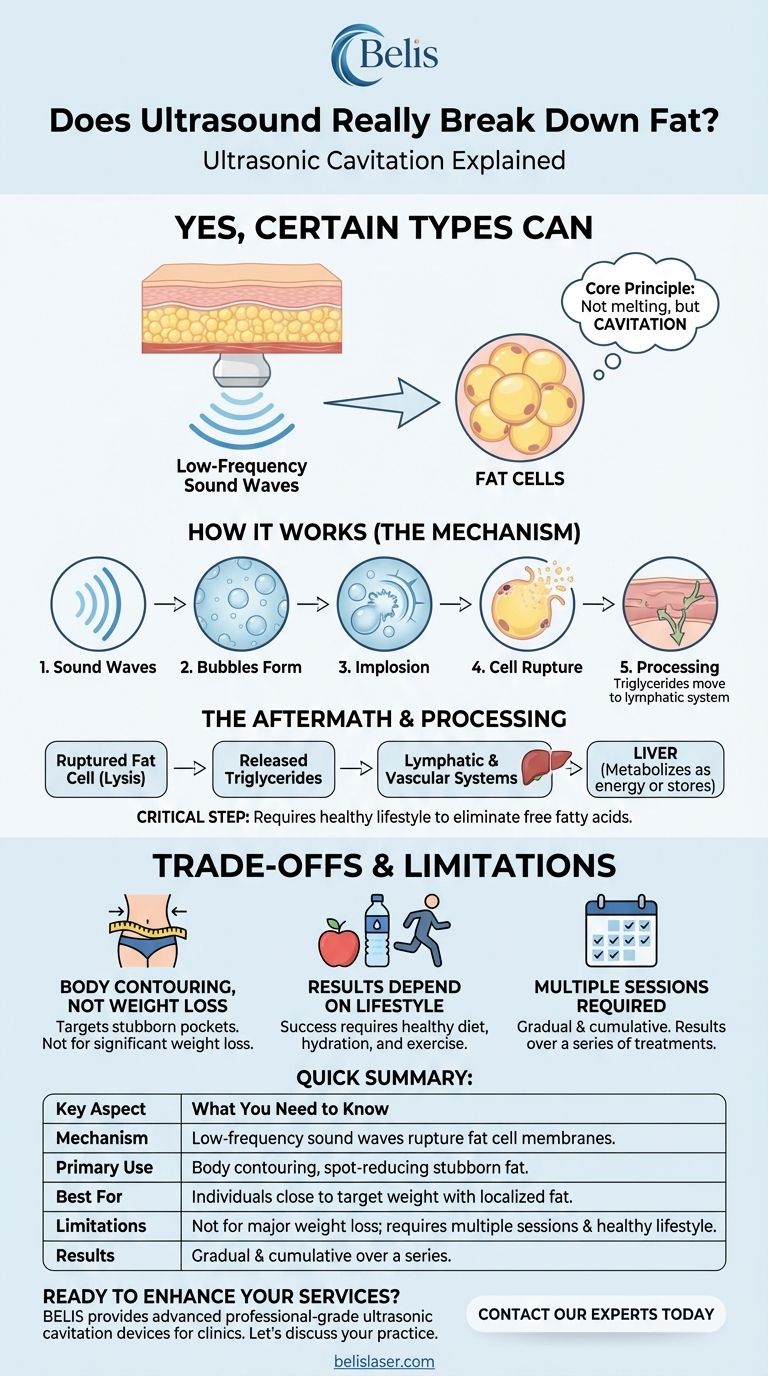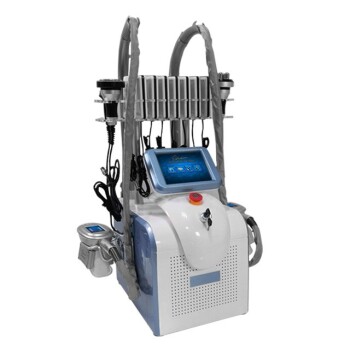Yes, certain types of ultrasound can break down fat cells. This process, known as ultrasonic cavitation, uses low-frequency sound waves to target and rupture the membranes of fat cells in a specific area. The procedure is non-invasive and distinct from diagnostic ultrasound used in medical imaging.
The core principle is not that sound "melts" fat, but that it creates a specific physical phenomenon—cavitation—that selectively damages fat cells. The body's natural metabolic and lymphatic systems are then responsible for clearing the resulting cellular debris.

How Ultrasound Induces Fat Cell Lysis
To understand its effectiveness, you must first understand the mechanism. The process is not chemical or thermal; it is purely mechanical, happening at a microscopic level.
The Principle of Cavitation
Ultrasonic cavitation devices transmit low-frequency sound waves into the body. These waves create a cycle of high and low pressure in the interstitial fluid surrounding the fat cells.
During the low-pressure phase, these waves cause the formation of microscopic bubbles or voids. This is cavitation.
As the sound waves continue, these bubbles rapidly expand and then collapse (implode) during the high-pressure phase. This implosion generates a significant shockwave and a surge of energy.
Targeting Adipose Tissue
The membranes of fat cells (adipocytes) are relatively brittle and large, making them particularly vulnerable to the pressure changes and shockwaves generated by cavitation.
The energy from the imploding bubbles is sufficient to stretch and rupture the adipocyte membrane, releasing its contents—primarily triglycerides—into the surrounding fluid.
Other tissues, such as blood vessels, nerves, and connective tissue, have different structural properties and are more resilient to this specific type of acoustic stress, which is why the procedure is considered selective.
The Aftermath: Processing the Byproducts
Once the fat cell is ruptured, it undergoes lysis (disintegration). The released triglycerides are then processed by the body.
The triglycerides are transported through the lymphatic and vascular systems to the liver. The liver does not distinguish between fat from cavitation and fat from your diet, metabolizing it through normal pathways.
This final step is critical. The body must process and eliminate these free fatty acids. If they are not used for energy, they can potentially be re-stored in other fat cells.
Understanding the Trade-offs and Limitations
While the science is sound, the practical application has important limitations that must be understood to set realistic expectations.
It's a Contouring Tool, Not a Weight-Loss Solution
Ultrasonic cavitation is designed for body contouring and targeting stubborn, localized pockets of fat that are resistant to diet and exercise.
It is not effective for significant, overall weight loss. The volume of fat removed in a single session is small compared to what can be achieved through a sustained caloric deficit.
Results Depend on a Healthy Lifestyle
The success of the treatment is highly dependent on your body's ability to process the released fat.
For this reason, practitioners universally recommend maintaining a healthy diet, staying well-hydrated, and engaging in regular physical activity. Without this, the released fat is likely to be stored again, negating the results.
Multiple Sessions Are Required
Results from ultrasonic cavitation are gradual and cumulative. A single session will not produce a dramatic change.
A typical treatment plan involves a series of sessions, often spaced a week apart, to achieve the desired contouring effect and allow the body time to process the byproducts between treatments.
Making the Right Choice for Your Goal
Understanding this technology allows you to decide if it aligns with your specific objectives.
- If your primary focus is spot-reducing a stubborn area: Ultrasonic cavitation can be a viable, non-invasive tool for contouring, provided you have realistic expectations and support it with a healthy lifestyle.
- If your primary focus is significant overall weight loss: This is not the correct approach; your efforts should be centered on creating a sustainable caloric deficit through diet and exercise.
- If your primary focus is a one-time, dramatic transformation: You may need to consider more invasive procedures like liposuction, which physically removes a much larger volume of fat cells from the body.
Ultimately, ultrasonic cavitation is a legitimate technology for its intended purpose, but its success is entirely dependent on its proper application and the user's lifestyle.
Summary Table:
| Key Aspect | What You Need to Know |
|---|---|
| Mechanism | Uses low-frequency sound waves to rupture fat cell membranes (cavitation). |
| Primary Use | Body contouring and spot-reducing stubborn fat pockets. |
| Best For | Individuals close to their target weight with localized fat. |
| Limitations | Not for significant weight loss; requires multiple sessions and a healthy lifestyle. |
| Results Timeline | Gradual and cumulative; visible over a series of treatments. |
Ready to enhance your body contouring services with professional-grade technology?
BELIS specializes in providing advanced, safe, and effective medical aesthetic equipment for clinics and premium beauty salons. Our ultrasonic cavitation devices are designed to deliver reliable, non-invasive fat reduction results for your clients, helping you expand your service offerings and grow your business.
Let's discuss how our professional solutions can benefit your practice. Contact our experts today for a personalized consultation.
Visual Guide

Related Products
- Ultrasonic Cavitation Radiofrecuency Machine for Body Slimming
- Cryolipolysis Fat Freezing Machine and Ultrasonic Cavitation Device
- Cryolipolysis Fat Freezing Machine Ultrasonic Cavitation Fat Reducing Device
- 12D HIFU Machine Device for Facial HIFU Treatment
- EMSlim Body Sculpting Machine EMS Body Slimming Machine
People Also Ask
- What are the restrictions for cavitation? Ensure Your Safety and Treatment Success
- When should you not use a cavitation machine? Critical Safety Guidelines for Aesthetic Treatments
- What are the negative side effects of cavitation? Understanding the Risks for Your Practice
- What does a cavitation machine do for your body? Sculpt Your Contours Without Surgery
- How many RF sessions do you need to see results? Achieve firmer, tighter skin with a personalized plan.



















